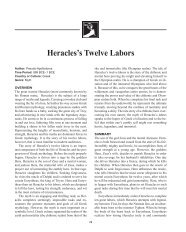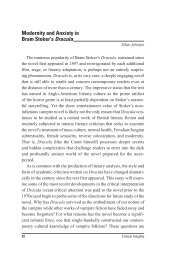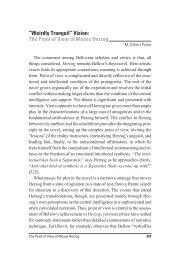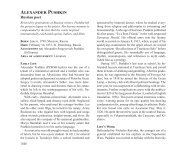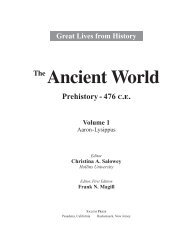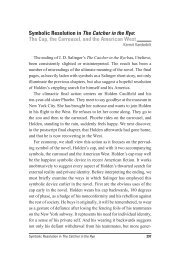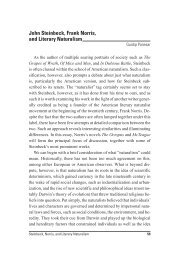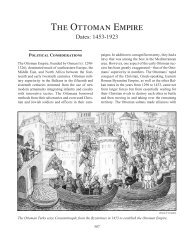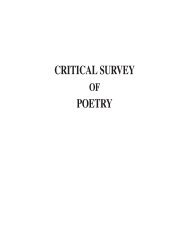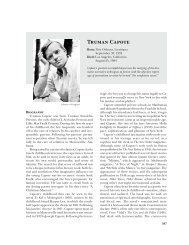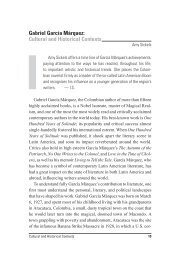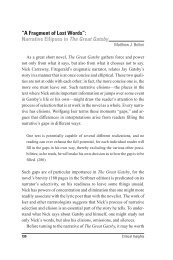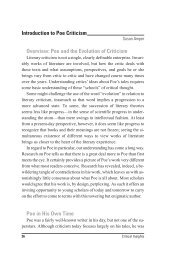The Historical and Social Context of Gwendolyn ... - Salem Press
The Historical and Social Context of Gwendolyn ... - Salem Press
The Historical and Social Context of Gwendolyn ... - Salem Press
You also want an ePaper? Increase the reach of your titles
YUMPU automatically turns print PDFs into web optimized ePapers that Google loves.
2. See also <strong>Gwendolyn</strong> Brooks <strong>and</strong> Working Writers (edited by Jacqueline Imani<br />
Bryant), <strong>The</strong> Chicago Collective: Poems for <strong>and</strong> Inspired by <strong>Gwendolyn</strong> Brooks (Stephen<br />
Caldwell Wright), <strong>and</strong> To Gwen with Love: An Anthology Dedicated to <strong>Gwendolyn</strong><br />
Brooks (edited by Patricia L. Brown, Don L. Lee, <strong>and</strong> Francis Ward).<br />
3. <strong>The</strong>se discussions include articles by Barbara Christian <strong>and</strong> Valerie Frazier.<br />
4. For further consideration <strong>of</strong> Brooks’s literary background, including the poetry<br />
<strong>of</strong> Paul Laurence Dunbar, Melvin B. Tolson, Robert E. Hayden, Emily Dickinson, <strong>and</strong><br />
Wallace Stevens, see “‘Down the Whirlwind <strong>of</strong> Good Rage’: An Introduction to<br />
<strong>Gwendolyn</strong> Brooks” by Maria K. Mootry.<br />
5. For further discussion <strong>of</strong> Chicago writers, see “‘Down the Whirlwind <strong>of</strong> Good<br />
Rage’” by Mootry <strong>and</strong> American Voices <strong>of</strong> the Chicago Renaissance <strong>and</strong> “From Chicago<br />
Renaissance to Chicago Renaissance: <strong>The</strong> Poetry <strong>of</strong> Fenton Johnson” by Lisa<br />
Woolley. Woolley supports <strong>and</strong> problematizes the argument that there were two successive<br />
Chicago Renaissances, a white one that included Carl S<strong>and</strong>burg, <strong>The</strong>odore<br />
Dreiser, <strong>and</strong> Edgar Lee Masters <strong>and</strong> a black one that included Margaret Walker,<br />
<strong>Gwendolyn</strong> Brooks, <strong>and</strong> Richard Wright.<br />
6. Lynching in the United States was instituted by slave owners as a means to control<br />
slaves through murder <strong>and</strong> terror. <strong>The</strong> practice continued long after emancipation<br />
<strong>and</strong> into the mid-twentieth century. In the final decades <strong>of</strong> the nineteenth century alone,<br />
several thous<strong>and</strong> people, mainly blacks, were lynched in the United States. Although<br />
lynchings most <strong>of</strong>ten sprung from accusations <strong>of</strong> murder or robbery, it was “the sexual<br />
fears, guilt, <strong>and</strong> fantasies <strong>of</strong> white men <strong>and</strong> sometimes women (<strong>and</strong> to an almost negligible<br />
degree the actions <strong>of</strong> black men) play[ing] a role in lynching [that] became a central<br />
motif in literary representations” (Callahan 465). This motif is borne out in<br />
Brooks’s treatments <strong>of</strong> lynching in “Ballad <strong>of</strong> Pearl May Lee,” “A Bronzeville Mother<br />
Loiters in Mississippi. Meanwhile, a Mississippi Mother Burns Bacon,” <strong>and</strong> “<strong>The</strong> Last<br />
Quatrain <strong>of</strong> the Ballad <strong>of</strong> Emmett Till.”<br />
7. In addition, grotesque racism persisted not only among individuals but also within<br />
institutions. For example, as Jennifer C. James notes, “the War Department insisted<br />
that black blood donations not be given to white soldiers in spite <strong>of</strong> the American Medical<br />
Association’s <strong>and</strong> Red Cross’s protestations that theories <strong>of</strong> ‘tainted’ black blood<br />
had no basis in science” (James 236). See James’s discussion <strong>of</strong> Brooks’s sonnet (237).<br />
8. For further discussion <strong>of</strong> the Second Black Writers’ Conference at Fisk University,<br />
see George E. Kent’s A Life <strong>of</strong> <strong>Gwendolyn</strong> Brooks (194-202). For further discussion<br />
<strong>of</strong> the poets <strong>of</strong> the Black Arts movement, see William W. Cook’s “<strong>The</strong> Black Arts<br />
Poets.”<br />
9. For further discussion <strong>of</strong> the references in “Riot,” see D. H. Melhem’s <strong>Gwendolyn</strong><br />
Brooks: Poetry <strong>and</strong> the Heroic Voice (192-95).<br />
10. In 1971 Brooks compiled A Broadside Treasury, 1965-1970, one <strong>of</strong> the best collections<br />
<strong>of</strong> the works <strong>of</strong> poets associated with the Black Arts movement. <strong>The</strong> volume<br />
includes poetry by several dozen writers, including Don L. Lee, Walter Bradford, <strong>and</strong><br />
Keorapetse Kgositsile, all <strong>of</strong> whom Brooks addresses in “Young Heroes.” <strong>The</strong> collection<br />
also includes a large group <strong>of</strong> poems honoring the slain Malcolm X <strong>and</strong> a poem by<br />
Brooks eulogizing Dr. Martin Luther King, Jr., that appeared in the Chicago Daily<br />
News the day after his death.<br />
36 Critical Insights



